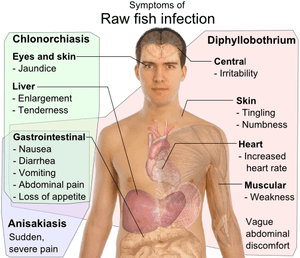Diphyllobothriasis
Diphyllobothriasis is the infection caused by tapeworms of the genus Diphyllobothrium, commonly Diphyllobothrium latum and Diphyllobothrium nihonkaiense.
| Diphyllobothriasis | |
|---|---|
| Specialty | Infectious disease |
Signs and symptoms

Diphyllobothriasis can last for decades if untreated. Most infections are asymptomatic. Manifestations may include abdominal discomfort, diarrhea, vomiting and weight loss. Vitamin B12 deficiency with subsequent megaloblastic anemia may occur, but has not for several decades in D. latum infections, possibly because of improved nutrition. In one test, nearly half of the ingested vitamin was absorbed by D. latum in otherwise healthy patients, while 80–100% was absorbed by the worm in patients with anemia. It is not known why anemia occurs in some cases but not others. Massive infections may result in intestinal obstruction. Migration of proglottids can cause cholecystitis or cholangitis.
Females cases are disproportionately reported, most likely due to the higher likelihood for them to be involved in meal preparation, rather than any morphological differences.
Diagnosis
Microscopic identification of eggs in the stool is the basis of specific diagnosis. Eggs are usually numerous and can be demonstrated without concentration techniques. Examination of proglottids passed in the stool is also of diagnostic value.
Diagnostic tool:
- Microscopy
- Morphologic comparison with other intestinal parasites
Though it is difficult to identify the eggs or proglottids to the species level, the distinction is of little medical importance because, like most adult tapeworms in the intestine, all members of this genus respond to the same drugs.
Prevention
Avoid ingestion of raw freshwater fish. Adequate cooking or freezing of freshwater fish will kill the encysted fish tapeworm larvae. Also, because human feces is an important mechanism for spreading eggs, proper disposal of sewage can cut down on infection of fish and thus of humans.
Treatment
Upon diagnosis, treatment is quite simple and effective. The standard treatment for diphyllobothriasis, as well as many other tapeworm infections is a single dose of praziquantel, 5–10 mg/kg orally once for both adults and children. An alternative treatment is niclosamide, 2 g orally once for adults or 50 mg/kg (max 2 g) for children.[6][7][8] Praziquantel is not FDA-approved for this indication and niclosamide is not available for human or even animal use in the United States.[6] Reportedly, albendazole can also be effective.[9][10] Another interesting potential diagnostic tool and treatment is the contrast medium, Gastrografin, introduced into the duodenum, which allows both visualization of the parasite, and has also been shown to cause detachment and passing of the whole worm.[11][12]
Epidemiology
Diphyllobothriasis occurs in areas where lakes and rivers coexist with human consumption of raw or undercooked freshwater fish. Such areas are found in Europe, newly independent states of the former Soviet Union, North America, Asia, Uganda, Peru (because of ceviche), and Chile. Diphyllobothriasis nihonkaiense was once endemic to coastal provinces of central and northern Japan, where salmon fisheries thrived.[13] In recent decades, regions with endemic diphyllobothriasis nihonkaiense have disappeared from Japan, though cases continue to be reported among urbanites who consume sushi or sashimi.[13] In Kyoto, it is estimated that the average incidence in the past 20 years was 0.32 cases per 100,000 population per year, and that in 2008 was 1.0 case per 100,000 population, suggesting that D. nihonkaiense infection is equally as prevalent in Japan as D. latum is in some European countries.[13]
The disease is rare in the United States. It was, however, once more common and was referred to as "Jewish housewife's disease" because Jewish housewives preparing the traditional "gefilte fish" frequently tasted the fish before it was cooked.
References
- WaiSays: About Consuming Raw Fish Retrieved on April 14, 2009
- For Chlonorchiasis: Public Health Agency of Canada > Clonorchis sinensis – Material Safety Data Sheets (MSDS) Retrieved on April 14, 2009
- For Anisakiasis: WrongDiagnosis: Symptoms of Anisakiasis Retrieved on April 14, 2009
- For Diphyllobothrium: MedlinePlus > Diphyllobothriasis Updated by: Arnold L. Lentnek, MD. Retrieved on April 14, 2009
- For symptoms of diphyllobothrium due to vitamin B12-deficiency University of Maryland Medical Center > Megaloblastic (Pernicious) Anemia Retrieved on April 14, 2009
- "Diphyllobothrium – Resources for Health Professionals". Parasites – CDC. 2012-01-10. Retrieved 2015-09-05.
- "Helminths: Cestode (tapeworm) infection: Niclosamide". WHO Model Prescribing Information: Drugs Used in Parasitic Diseases – Second Edition. WHO. 1995. Retrieved 2015-09-05.
- "Helminths: Cestode (tapeworm) infection: Praziquantel". WHO Model Prescribing Information: Drugs Used in Parasitic Diseases – Second Edition. WHO. 1995. Retrieved 2015-09-05.
- Molodozhnikova NM, Volodin AV, Bakulina NG (Nov–Dec 1991). "[The action of albendazole on the broad tapeworm]". Meditsinskaia Parazitologiia I Parazitarnye Bolezni (in Russian). Moscow (6): 46–50. PMID 1818249.
- Jackson Y, Pastore R, Sudre P, Loutan L, Chappuis F (Dec 2007). "Diphyllobothrium latum outbreak from marinated raw perch, Lake Geneva, Switzerland". Emerging Infectious Diseases. 13 (12): 1957–1958. doi:10.3201/eid1312.071034. PMC 2876774. PMID 18258060.
- Waki K, Oi H, Takahashi S, et al. (1986). "Successful treatment of Diphyllobothrium latum and Taenia saginata infection by intraduodenal 'Gastrografin' injection". Lancet. 2 (8516): 1124–6. doi:10.1016/S0140-6736(86)90532-5. PMID 2877274.
- Ko, S.B. “Observation of deworming process in intestinal Diphyllobothrium latum parasitism by Gastrografin injection into jejunum through double-balloon enteroscope.” (2008) from Letter to the Editor; American Journal of Gastroenterology, 103; 2149–2150.
- Arizono, Naoki; Yamada, Minoru; Nakamura-Uchiyama, Fukumi; Ohnishi, Kenji (June 2009). "Diphyllobothriasis Associated with Eating Raw Pacific Salmon". Emerging Infectious Diseases. 15 (6): 866–870. doi:10.3201/eid1506.090132. PMC 2727320. PMID 19523283.
External links
| Classification | |
|---|---|
| External resources |
- "Diphyllobothriasis". CDC – DPDx – Laboratory Identification of Parasitic Diseases of Public Health Concern. 2013-11-29. Retrieved 2015-09-05.